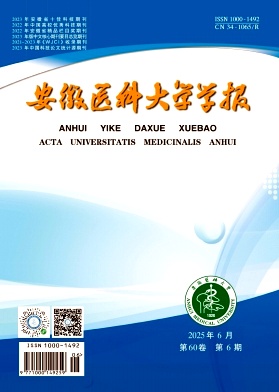| 148 | 0 | 90 |
| 下载次数 | 被引频次 | 阅读次数 |
目的 制备负载大蒜新素——二烯丙基三硫化物(DATS)的中空介孔硅纳米微球(HMSNs),并研究其作为下肢缺血性损伤治疗剂的可行性。方法 采用选择性蚀刻法合成出HMSNs,同时利用扫描和透射电镜观察微观结构,X射线衍射和动态光散射(DLS)分析理化性质,红细胞溶血实验和细胞毒性实验测试生物安全性。采用吸附法将DATS负载至HMSNs里,获得缓释DATS的纳米颗粒(DATS-HMSNs),并用紫外分光光度法计算并制作DATS的累积释放曲线。将C57BL/6小鼠随机分为四组(假手术组、0.9%氯化钠注射液组、DATS组、DATS-HMSNs组),下肢缺血模型采用股动脉结扎切除法制作。测试各组小鼠肢体缺血前后的运动能力和肌肉内肿瘤坏死因子-α(TNF-α)、白细胞介素-6(IL-6)、单核细胞趋化蛋-1 (MCP-1)、活性氧(ROS)、血小板内皮细胞黏附分子(CD31)、α-平滑肌肌动蛋白(α-SMA)、碱性成纤维细胞生长因子(bFGF)和血管内皮生长因子(VEGF)含量的变化。结果 扫描和透射电镜观察可见制备出的HMSNs为中空的球形且粒径均一,DLS结果显示粒径为(226.5±11.8)nm。红细胞溶血实验及细胞毒性实验结果表明HMSNs具备良好的生物相容性。HMSNs对DATS的最大载药率为27.89%,7 d DATS的累积释放率80.12%,21 d可达到97.27%。与对照组比较,DATS-HMSNs用于下肢缺血小鼠后,免疫组化染色发现CD31、α-SMA、bFGF及VEGF的水平增高(P<0.05),ELISA实验发现TNF-α、IL-6、MCP-1和ROS的含量减低(P<0.05),并且缺血后小鼠运动能力恢复满意。结论 DATS-HMSNs可以缓慢、持续地释放DATS,为下肢缺血性损伤提供保护作用。
Abstract:Objective To prepare hollow mesoporous silicon nanoparticles(HMSNs) loaded with allicin—diallyl trisulfide(DATS), and to study their feasibility as a therapeutic agent for ischemic injury of lower limbs. Methods HMSNs were synthesized by selective etching, and their microstructure was observed by scanning and transmission electron microscopy. Their physical and chemical properties were analyzed by X-ray diffraction and dynamic light scattering(DLS). Their biological safety was tested by erythrocyte hemolysis and cytotoxicity experiments. DATS was loaded into HMSNs by adsorption to obtain DATS sustained release nanoparticles(DATS-HMSNs), and the cumulative release curve of DATS was calculated and produced by ultraviolet spectrophotometry. C57BL/6 mice were randomly divided into four groups(sham operation group, normal saline group, DATS group, and DATS-HMSNs group). Lower limb ischemia models were made by femoral artery ligation and resection. The exercise ability and the contents of tumor necrosis factor alpha(TNF-α), interleukin-6(IL-6), monocyte chemoattractant protein-1(MCP-1), reactive oxygen species(ROS), platelet-endothelial cell adhesion molecule(CD31), alpha smooth muscle actin(α-SMA), basic fibroblast growth factor(bFGF) and vascular endothelial growth factor(VEGF) in muscles of mice in each group before and after limb ischemia were tested. Results Scanning and transmission electron microscope observation showed that the prepared HMSNs were hollow, spherical and uniform in particle size. DLS results showed that the particle size was(226.5±11.8) nm. The results of red blood cell hemolysis test and cytotoxicity test showed that HMSNs had good biocompatibility. The maximum drug loading rate of HMSNs on DATS was 27.89%, the cumulative release rate of DATS in 7 days was about 80.12%, and could reach 97.27% in 21 days. Compared with the control group, after DATS-HMSNs were applied to mice with lower limb ischemia, immunohistochemical staining showed that the levels of CD31, α-SMA, bFGF and VEGF increased(P<0.05). Elisa test showed that the levels of TNF-α, IL-6, MCP-1 and ROS decreased(P<0.05), and the exercise ability of mice recovered satisfactorily after ischemia. Conclusion DATS-HMSNs can release DATS slowly and continuously, providing protection against ischemic injury of lower limbs.
[1] Farber A.Chronic limb-threatening ischemia[J].N Engl J Med,2018,379(2):171-80.doi:10.1056/NEJMcp1709326.
[2] Puccinelli M T,Stan S D.Dietary bioactive diallyl trisulfide in cancer prevention and treatment[J].Int J Mol Sci,2017,18(8):E1645.doi:10.3390/ijms18081645.
[3] Zhang T,Ouyang H,Liu S,et al.pH/Thermosensitive dual-responsive hydrogel based sequential delivery for site-specific acute limb ischemia treatment[J].J Mater Chem B,2022,10(38):7836-46.doi:10.1039/d2tb00474g.
[4] Hosono T,Sato A,Nakaguchi N,et al.Diallyl trisulfide inhibits platelet aggregation through the modification of sulfhydryl groups[J].J Agric Food Chem,2020,68(6):1571-8.doi:10.1021/acs.jafc.9b05557.
[5] Rose P,Moore P K,Zhu Y Z.Garlic and gaseous mediators[J].Trends Pharmacol Sci,2018,39(7):624-34.doi:10.1016/j.tips.2018.03.009.
[6] Adepu S,Ramakrishna S.Controlled drug delivery systems:current status and future directions [J].Molecules,2021,26(19):5905.doi:10.3390/molecules26195905.
[7] Guo L,Ping J,Qin J,et al.A comprehensive study of drug loading in hollow mesoporous silica nanoparticles:impacting factors and loading efficiency[J].Nanomaterials,2021,11(5):1293.doi:10.3390/nano11051293.
[8] Ismaeel A,Papoutsi E,Miserlis D,et al.The nitric oxide system in peripheral artery disease:connection with oxidative stress and biopterins[J].Antioxidants,2020,9(7):590.doi:10.3390/antiox9070590.
[9] Hutchings G,Kruszyna L,Nawrocki M J,et al.Molecular mechanisms associated with ROS-dependent angiogenesis in lower extremity artery disease[J].Antioxidants,2021,10(5):735.doi:10.3390/antiox10050735.
[10] Ding H,Chang J,He F,et al.Hydrogen sulfide:an emerging precision strategy for gas therapy[J].Adv Healthc Mater,2022,11(4):e2101984.doi:10.1002/adhm.202101984.
[11] Kolluru G K,Shackelford R E,Shen X,et al.Sulfide regulation of cardiovascular function in health and disease[J].Nat Rev Cardiol,2023,20(2):109-25.doi:10.1038/s41569-022-00741-6.
[12] Jia J,Li J,Cheng J.H2S-based therapies for ischaemic stroke:opportunities and challenges[J].Stroke Vasc Neurol,2019,4(2):63-6.doi:10.1136/svn-2018-000194.
[13] Hu J,Xue Y,Tang K,et al.The protective effects of hydrogen sulfide on the myocardial ischemia via regulating BMAL1[J].Biomed Pharmacother,2019,120:109540.doi:10.1016/j.biopha.2019.109540.
[14] Sun H J,Wu Z Y,Nie X W,et al.Implications of hydrogen sulfide in liver pathophysiology:mechanistic insights and therapeutic potential[J].J Adv Res,2021,27:127-35.doi:10.1016/j.jare.2020.05.010.
[15] Zhao Y,Wang H,Xian M.Cysteine-activated hydrogen sulfide (H2S) donors [J].J Am Chem Soc,2011,133(1):15-7.doi:10.1021/ja1085723.
基本信息:
DOI:10.19405/j.cnki.issn1000-1492.2025.02.003
中图分类号:R543;R943
引用信息:
[1]欧阳欢,刘博,刘逸等.大蒜新素纳米缓释颗粒的制备及其对下肢缺血保护作用的实验研究[J].安徽医科大学学报,2025,60(02):201-209.DOI:10.19405/j.cnki.issn1000-1492.2025.02.003.
基金信息:
安徽省高等学校自然科学研究项目(编号:KJ2020A0195)~~

